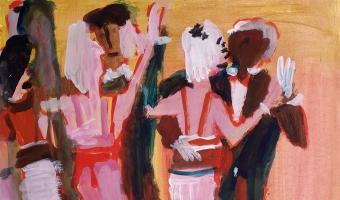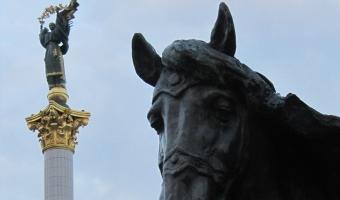Gerta Nemenova - Leningrad Parisian - 115th Anniversary Exhibition
Gerta Nemenova (1905-1986)
People who knew Gerta Nemenova remember her as, “An unusual artist and a very unusual person. Her way of thinking, way of life, her art, all were strange and unacceptable for some, and highly attractive for others. The obvious talent, conviction of views on art, and undoubted decency attracted many to her, and she had a stable group of loyal friends of various ages”. (1)
Gerta Nemenova (1905-1986) was born in Berlin, where her father, M. I. Nemenov, future founder of the Institute of X-Ray and Radiology (1918) and Leningrad Military-Medical Academy X-Ray Department Head, was studying to be a doctor,
She studied at the Academy of Arts in Leningrad (1925-1929) with Petrov-Vodkin and Nathan Altman. She participated in exhibitions from the age of eighteen, and first presented work at the 1923 Exhibition of Paintings of Petrograd Artists of All Directions, and then in the Third Exhibition of the “Circle of Artists” in 1929.
For Nemenova, travel to Paris (1929-1930) became the turning point in her life and creativity. There, she studied at the Academie Moderne with Fernand Leger. Natalya Goncharova and Mikhail Larionov looked after her. Larionov on occasion even introduced her to Pablo Picasso. During the little over a year spent in Paris, Nemenova used her time productively. “Autumn 1930, she managed to exhibit one of her canvases at the Salon d'Automne, and five at the 3rd Salon des Indépendants. It was an unquestionable success, and Gerta Mikhailovna carried the memory through her entire life. Overall, the comparison to Paris and to contemporary French art remained a theme for her until the end of her days. Would her new works compete with the French? That thought was always troubling her, wounding her at different periods of her life, right up until her last years. Perhaps, for this reason, participation in Leningrad and domestic exhibitions in general was not of interest.”(2)
During the 1950’s, she was a frequent visitor to Anna Akhmatova at the Fountain House, and in 1957 she made a few pencil sketches which became the basis for the [portrait] lithograph [of Akhmatova]. “Evidence of Akhmatova’s affinity for the art of Gerta Nemenova is evidenced in a dedication inscription in one of the few poetry books from those years, “To Gerta Nemenova – author of strident and interesting portraits. Akhmatova 18 Apr. 1961.” (3)
The N. V. Gogol portrait (1959) brought Nemenova world-wide success, and became one of the portraits from her gallery of artistic and cultural portraits not executed from life: Franz Kafka (1966), F. Dostoevsky (1968), A. Blok (1970), A. Greene (1973), A. Pushkin (1976), B. Pasternak (1977), Charlie Chaplin (1970’s) and K. Malevich (1985).
Izrailevich along with Nemenova, were introduced to Valentin Levitin and Zhanna Brovina (and Zhanna’s portrait, Nemenova completed later) and through them they met other representatives of the unofficial Leningrad culture scene. In the 1970’s, Nemenova’s place became a hub for artists, poets, artists of the underground. The poets K. Kuzminsky, V. Eril, E. Bogdanov visited her, as well as the artists, A. Belkin, and E. Mikhnov-Voitenko. In the 1980’s, Timur Novikov, future leader of the neo-academics movement also visited. All of them were attracted to the bright personality and unusual artistry of Nemenova, her honesty and the strength of her art.
On one of the posters for a posthumous Nemenova exhibition the artist’s words are quoted: “Everything in art is permitted – thus I take the path of tyranny and oppose it (this way) in all systems. This “visible” tyranny consists of components, the inter-connection is subject to tight control “within oneself” in the process of work. It is selection and judgement and experience that is the unexpected arising in the process of the work, then to be either accepted or rejected. The advantage of this path – it is genuine, not invented after everything has been done by someone. It is difficult to work each time like the first time; but if you win, you have created something unlike anything else ever. These systems are also arbitrary. A few rules, diagrams and methods help to do something, but these schools, without your own processing will remain mechanical imitation, or at best – a deviation.” (4)
Recollections of Grigori Izrailevich (1929-1999)
It brings me great joy to think about and remember her. This was a person of tremendous talent, taste and goodwill. When I was being admitted to the Artists’ Union Section Bureau, I organised an exhibition, well actually kind-hearted Pavel Ivanovich Basmanov organised it. Ten people were present at the Bureau. The Section Chairman Vetrogonsky, a deeply unprincipled fellow, said: “In controversial instances I have two votes and vote against”. A long uncomfortable silence reigned. When suddenly – a miracle: the door swung open and in came Vera Matyukh, a Bureau member. “What wonderful works. I vote – Yes!” Suddenly, the situation turned in my favour, 5-6. Gerta was pacing outside the door the entire time and worrying. “Congratulations!”, she said. “So, there is justice.” My candidacy passed to the Board unanimously. Gerta usually would come to print at the workshop at the end of the day. It seemed that she would always be caught up in some escapade. She was often backstage at the theatre, first they would let her in, then not let her in, then there would be some stories of strange encounters – and I would listen attentively, understanding nothing. Her appraisals were always sincere. Once, I showed her some of my monotypes. She commented, “I cannot understand, is it rubbish or wonderful?” Incidentally, that always remained a question for me as well. Gerta called and asked to stop by to collect some works. I said to her, “Gerda dear, no matter what you do, it is always Nemenova, everything else is unimportant”. She as no one else had mastery of sketch art. Always sharp, laconic and interesting. She drew in such as way as to feel her subjugation of the material. There was a tension, a strength. She expressed haute culture. The fact that she lived for a long time in Paris with Larionov and Goncharova, studied with Fernand Leger was evident. She had exquisite taste and most importantly sincere appraisals. Gerta loved to discover people, I would not say talents. And in a way, she collected them. She was ill for a long time. I visited her at the hospital, sat next to her, offered her fruit that I brought, or water. With a weak gesture, she once shooed me away, as if she wanted to sleep. I told the duty nurse that I would walk in the Sosnovyi Park nearby and return in two hours, but by then she was gone. The last years, she would say when she saw me, “Shave that vile beard! You were such a D’Artagnan!”
Most of all I enjoyed looking at her drawings – the drawings and sketches were closer to my heart, especially the drawings that were executed as if with one line. If for the Japanese, or Chinese artist this is natural, a European injects more into a picture, to perfection, to busyness. I love the sketch, but especially the one in which there is both tension and though, and naturally a sketch must be laconic, as a rhyme. Gerta Nemenova’s great creativity distilled into her concise drawings. She despaired that few bought her works, I assured her that this was out of ignorance.(5)
1. Yuri Rusakov , Gerta Nemenova, Exhibition Catalogue, Muzei Akhmatovoi v Fontannom Dome, (St. Petersburg: AO “Arsis”, 1993)
2. Ibid, p. 4
3. Ibid, p. 9-10
4. Kononikhin, Nikolai, Leningrad Lithography: Meeting Place, St. Petersburg: 2017
5. Izrailevich, Grigori, from: Puskaya mylnye puzyri. Shchepki drovinisma [Blowing Bubbles: Acute Traces of Absurdity], 2nd Edition, Moscow: 2003.
People who knew Gerta Nemenova remember her as, “An unusual artist and a very unusual person. Her way of thinking, way of life, her art, all were strange and unacceptable for some, and highly attractive for others. The obvious talent, conviction of views on art, and undoubted decency attracted many to her, and she had a stable group of loyal friends of various ages”. (1)
Gerta Nemenova (1905-1986) was born in Berlin, where her father, M. I. Nemenov, future founder of the Institute of X-Ray and Radiology (1918) and Leningrad Military-Medical Academy X-Ray Department Head, was studying to be a doctor,
She studied at the Academy of Arts in Leningrad (1925-1929) with Petrov-Vodkin and Nathan Altman. She participated in exhibitions from the age of eighteen, and first presented work at the 1923 Exhibition of Paintings of Petrograd Artists of All Directions, and then in the Third Exhibition of the “Circle of Artists” in 1929.
For Nemenova, travel to Paris (1929-1930) became the turning point in her life and creativity. There, she studied at the Academie Moderne with Fernand Leger. Natalya Goncharova and Mikhail Larionov looked after her. Larionov on occasion even introduced her to Pablo Picasso. During the little over a year spent in Paris, Nemenova used her time productively. “Autumn 1930, she managed to exhibit one of her canvases at the Salon d'Automne, and five at the 3rd Salon des Indépendants. It was an unquestionable success, and Gerta Mikhailovna carried the memory through her entire life. Overall, the comparison to Paris and to contemporary French art remained a theme for her until the end of her days. Would her new works compete with the French? That thought was always troubling her, wounding her at different periods of her life, right up until her last years. Perhaps, for this reason, participation in Leningrad and domestic exhibitions in general was not of interest.”(2)
During the 1950’s, she was a frequent visitor to Anna Akhmatova at the Fountain House, and in 1957 she made a few pencil sketches which became the basis for the [portrait] lithograph [of Akhmatova]. “Evidence of Akhmatova’s affinity for the art of Gerta Nemenova is evidenced in a dedication inscription in one of the few poetry books from those years, “To Gerta Nemenova – author of strident and interesting portraits. Akhmatova 18 Apr. 1961.” (3)
The N. V. Gogol portrait (1959) brought Nemenova world-wide success, and became one of the portraits from her gallery of artistic and cultural portraits not executed from life: Franz Kafka (1966), F. Dostoevsky (1968), A. Blok (1970), A. Greene (1973), A. Pushkin (1976), B. Pasternak (1977), Charlie Chaplin (1970’s) and K. Malevich (1985).
Izrailevich along with Nemenova, were introduced to Valentin Levitin and Zhanna Brovina (and Zhanna’s portrait, Nemenova completed later) and through them they met other representatives of the unofficial Leningrad culture scene. In the 1970’s, Nemenova’s place became a hub for artists, poets, artists of the underground. The poets K. Kuzminsky, V. Eril, E. Bogdanov visited her, as well as the artists, A. Belkin, and E. Mikhnov-Voitenko. In the 1980’s, Timur Novikov, future leader of the neo-academics movement also visited. All of them were attracted to the bright personality and unusual artistry of Nemenova, her honesty and the strength of her art.
On one of the posters for a posthumous Nemenova exhibition the artist’s words are quoted: “Everything in art is permitted – thus I take the path of tyranny and oppose it (this way) in all systems. This “visible” tyranny consists of components, the inter-connection is subject to tight control “within oneself” in the process of work. It is selection and judgement and experience that is the unexpected arising in the process of the work, then to be either accepted or rejected. The advantage of this path – it is genuine, not invented after everything has been done by someone. It is difficult to work each time like the first time; but if you win, you have created something unlike anything else ever. These systems are also arbitrary. A few rules, diagrams and methods help to do something, but these schools, without your own processing will remain mechanical imitation, or at best – a deviation.” (4)
Recollections of Grigori Izrailevich (1929-1999)
It brings me great joy to think about and remember her. This was a person of tremendous talent, taste and goodwill. When I was being admitted to the Artists’ Union Section Bureau, I organised an exhibition, well actually kind-hearted Pavel Ivanovich Basmanov organised it. Ten people were present at the Bureau. The Section Chairman Vetrogonsky, a deeply unprincipled fellow, said: “In controversial instances I have two votes and vote against”. A long uncomfortable silence reigned. When suddenly – a miracle: the door swung open and in came Vera Matyukh, a Bureau member. “What wonderful works. I vote – Yes!” Suddenly, the situation turned in my favour, 5-6. Gerta was pacing outside the door the entire time and worrying. “Congratulations!”, she said. “So, there is justice.” My candidacy passed to the Board unanimously. Gerta usually would come to print at the workshop at the end of the day. It seemed that she would always be caught up in some escapade. She was often backstage at the theatre, first they would let her in, then not let her in, then there would be some stories of strange encounters – and I would listen attentively, understanding nothing. Her appraisals were always sincere. Once, I showed her some of my monotypes. She commented, “I cannot understand, is it rubbish or wonderful?” Incidentally, that always remained a question for me as well. Gerta called and asked to stop by to collect some works. I said to her, “Gerda dear, no matter what you do, it is always Nemenova, everything else is unimportant”. She as no one else had mastery of sketch art. Always sharp, laconic and interesting. She drew in such as way as to feel her subjugation of the material. There was a tension, a strength. She expressed haute culture. The fact that she lived for a long time in Paris with Larionov and Goncharova, studied with Fernand Leger was evident. She had exquisite taste and most importantly sincere appraisals. Gerta loved to discover people, I would not say talents. And in a way, she collected them. She was ill for a long time. I visited her at the hospital, sat next to her, offered her fruit that I brought, or water. With a weak gesture, she once shooed me away, as if she wanted to sleep. I told the duty nurse that I would walk in the Sosnovyi Park nearby and return in two hours, but by then she was gone. The last years, she would say when she saw me, “Shave that vile beard! You were such a D’Artagnan!”
Most of all I enjoyed looking at her drawings – the drawings and sketches were closer to my heart, especially the drawings that were executed as if with one line. If for the Japanese, or Chinese artist this is natural, a European injects more into a picture, to perfection, to busyness. I love the sketch, but especially the one in which there is both tension and though, and naturally a sketch must be laconic, as a rhyme. Gerta Nemenova’s great creativity distilled into her concise drawings. She despaired that few bought her works, I assured her that this was out of ignorance.(5)
1. Yuri Rusakov , Gerta Nemenova, Exhibition Catalogue, Muzei Akhmatovoi v Fontannom Dome, (St. Petersburg: AO “Arsis”, 1993)
2. Ibid, p. 4
3. Ibid, p. 9-10
4. Kononikhin, Nikolai, Leningrad Lithography: Meeting Place, St. Petersburg: 2017
5. Izrailevich, Grigori, from: Puskaya mylnye puzyri. Shchepki drovinisma [Blowing Bubbles: Acute Traces of Absurdity], 2nd Edition, Moscow: 2003.




